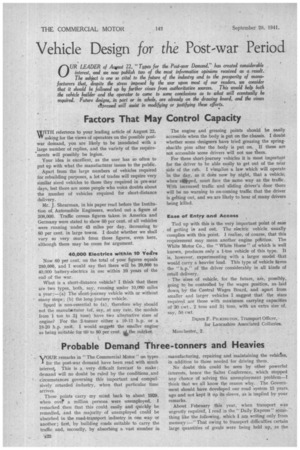Vehicle Design for the Post-war Period 0 UR LEADER of
Page 24

If you've noticed an error in this article please click here to report it so we can fix it.
August 22, "Types for the Post-war Demand," has created considerable interest, and we now publish two of the most informative opinions received as a result. The subject is one so vital to the future of the industry and to the prosperity of manufacturers that, despite the stress imposed by the war upon most of our readers, we consider that it should be followed up by further views from authoritative sources. This would help both the vehicle builder and the operator to come to some conclusions as to what will eventually be required. Future designs, in part Of in whole, are already on the drawing board, and the views
elpressed will assist in modifying or justifying these efforts.
Factors That May Control Capacity
WITH reference to your leading article of August 22, " asking for the views of operators on the possible postwar demand, you are likely to be inundated with a large number of replies, and the variety of the requirements will possibly be legion.
Your idea is excellent, as the user has so often to put up with what the manufacturer issues to the public.
Apart from the large numbers of vehicles required for rebuilding purposes, a lot of trades will require very similar sized vehicles to those they required in pre-war days. but these are some people who voice doubts about the number of vehicles required for short-distance delivery.
Mr. J. Shearman, in his paper read before the Institution of, Automobile Engineers, worked out a figure of 308,000. Traffic census figures taken. in America and Germany were stated to show 60 per cent. of all vehicles were running 'under 43 miles per day, increasing to 80 per cent, in large towns. I doubt whether we shall vary so very much from those figures, even here, although there may be room for argument.
40,000 Electrics within 10 Years Now 60 per cent, on the total of your figures equals 280,000, and I would say that there will be. 20,000 to 40,000 battery-electrics in use within 10 years of the end of the war.
What-is a short-distance vehicle? I think that there are two types, both, say, running under 10,060 miles a year ;—(a) The short-journey vehicle with or without many stops; (13) the long-journey vehicle.
Speed is non-essential to (a), therefore why should not the manufacturer (of, say, at any 'rate, the models from 1 ton to 2i tons) have two alternative sizes of engine? For the 2-tonner either a 10-12 h.p. or a 18-20 h.p. unit. I would suggett the smaller engine as being suitable for 60 to 80 per cent. the market. The engine and greasing points should be easily accessible when the body is put on the chassis. I doubt whether some designers have tried greasing the springshackle pins after the body is put on. If these are not accessible some drivers will not use tlem.
For these short-journey vehicles it is most important for the driver to be able easily to get out of the near side of the cab. I visualize a law which will operate in the day, as it does now by night, that a vehicle, when slipped, must face the same way as the traffic. With increased traffic and sliding driver's door there will be no warning to on-coming traffic that the driver is getting out, and we are likely to hear of many drivers being killed. '
Ease of Entry and Access Tied up with this is the very important point of ease of getting in and out. The electric vehicle_ usually complies with this point. I realize, of course, that this requirement may mean another engine potition. The White Motor Co., the "White Horse" of which is well known, produces only a 1-ton vehicle of this type. It is, however, experimenting with a larger model that would carry a heavier load. This type of vehicle gaves the " h.p." of 'the drivel' considerably in all kinds of retail delivery.
The sizes of vehicle, for the future, are, possibly. going to, be controlled by the wages position, as laid down, by the Central Wages Board, and apart from smaller and larger vehicles I suggest that the sizes required are those with maximum carrying capacities of -30 cwt., 2 tons and 3l tons, with an extra size of, say, 50 cwt.
DEms F. PILKINGTON, Transport Officer, for Lancashire Associated Collieries, Manchester, 2.




















































